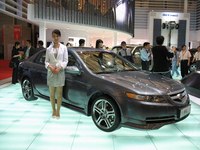Top 10 Most Unpopular Cars in China
 |
In the first half of this year, 34 new models have hit the market, and 21 of those were revamps of older models. Of those only a few flourished, so now Gasgoo will list those that flopped in The Top 10 Most Unpopular Cars in China.
1. Honda's Acura TL
Last September, one of Honda's most popular models was released in China with
hopes of American like popularity. Honda's main model in China, The Acura TL,
sold less than 200 units during the first six months of 2007. Acura met their Waterloo for their
unsuccessful marketing strategy.
The distributor offered a price-cut last month. Acura TL's advanced equipment, like the intelligent key and navigation system, were applied only on the demand of customers who would pay the bill. In contrast, most imported premier cars are readily equipped, so it's no wonder that Acura TL faced such a low sales result.
2 Mitsubishi Galant
Galant was released in China last November, but its sales were declining
during the first half of the year. The half-year result for Galant is 4062
units, not even half of Toyota Camry's monthly sales, though both models
belong to the same D-segment.
Initially the 2.4L version was priced at RMB199, 800 to 219,800, giving Galant a price advantage competing with Accord and Camry, but as price-cuts of Accord, Mondeo and Sonata went further, and lack of brand charisma came out, Galant's future in China is gloomy.
3. Fiat Perla
Fiat Perla, which is developed by Fiat and its Chinese joint venture partner,
went on sale last September. The Italian automaker chose
China as an all-new model's debut place for the first time, and this model
was Perla. Although this sedan has an exclusive 1.7-liter engine and a
Europe-developed chassis, Perla has half-year sales of roughly two thousand
units.
Perla was nicknamed as "car of revival" for the loss-making Nanjing Fiat Automobile, but for its resemblance with Fiat Siena, which is RMB20,000 cheaper than Perla, customers feel a reluctance to buy this new car. Currently Perla has monthly sales of only 300 units, well below the company's expectation.
4. Kia Rio
The new Kia Rio's performance fell short in spite of several price-cuts.
The automaker, Dongfeng Kia, expected to sell more than 5000 units per month,
and considered the model as its bread and butter, but since it's launch
early this year, Rio only sold 4,996 units up to now.
The old-generation Dongfeng KIA Rio could never be outperformed by the current new one.
5. FAW Vitz
Tianjin FAW Xiali Automobile Co. sold 904 units of Vitz during the first
half of year.
Since Toyota announced its plan to put the new Yaris into production next year, Vitz, which actually is the same model, is being threatened. Under the fierce competition from Polo, Fit and Peugeot 206, Vitz's sales are declining since the introduction in late 2002. The automaker lowered prices for the third time this June on its Vizi cars and planned to redesign it, but analysts say that Vitz has slim chances of a rebirth.
6 Suzuki Liana
Suziki Liana's half year sales are 5,416 units, which didn't sell as
expected despite considerable discounts offered.
Liana sedan was launched by Changhe Suzuki--- Suzuki's joint venture---in November 2005, and the hatch-back version hit the market in March 2006 in the wake of a flat market from the sedan. Unfortunately the Liana faced off with Chang'an Suzuki, another Suzuki joint venture in China. Though this model employs the original Suzuki M16A engine imported from Japan, most of its components are sourced from abroad so it's comparatively expansive.
This June, Changhe Suzuki sold a record-low 387 units of Liana.
7 Hyundai Sonata
Beijing Hyundai, Hyundai's joint venture in China, sold 7,808 units of
Sonata. This model is a success in the European and American markets, but
not in China.
NF Sonata, the new generation of Sonata, was introduced into China in 2005, and the revamped vehicle hit the market early this year. This model targets VW Passat, Toyota Accord and Buick Regal, but it failed to catch the consumers' attention for lack of brand halo.
8 Ford S-Max
The S-Max minivan posted a wholesale volume of 2,260 units in its first
half-year. S-Max's sales in the debuting month of March topped one thousand
units, but later declined to 173 units in June.
Unlike its Focus, Ford's cash cow in China, which grew by 66% to 55,676 units during the first six months, the S-Max is not in a fair wind. Currently the Chinese family MPV market was sluggish, so "The Car of the Year" in Europe failed to win customers. S-Max used to be priced between RMB219, 800 and RMB239, 800, but now the distributor offered a discount as much as RMB10, 000.
9 Toyota Prius
Toyota Prius' half-year sales-176 units-were restricted by the
prohibitive price and the yet-unformed eco-fashion.
Toyota's hybrid vehicles have hit the landmark 1,000,000 units by the end of May, and among which Prius is the overwhelming leader with the global sales reaching 757,600 units since its 1997 introduction in Japan. But the RMB300,000 sedans discourage the consumers because of the relatively small 1.5L engines. People here would rather buy a well-equipped high or medium-level sedan.
Prius was put into production in China in late 2005 by Sichuan FAW Toyota, one of China's joint vehicles.
10 GM Park Avenue
SAIC GM sold just 934 units of Park Avenue during the first six months.
This model, which is a rebadged Holden WM Caprice/Statesman, took the important task to upgrade the Buick brand, but its release helped little regarding its low market share. Park Avenue was set to replace Buick Royaum as the newest flagship model, the latter being out of production in order to make way for Park Avenue, but consumer doubt about its origin and lack of marketing baulked the highly-expected sedan.
For more information about the burgeoning auto industry in China please visit http://www.gasgoo.com/Autobiz/list/7/China-News.html



